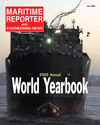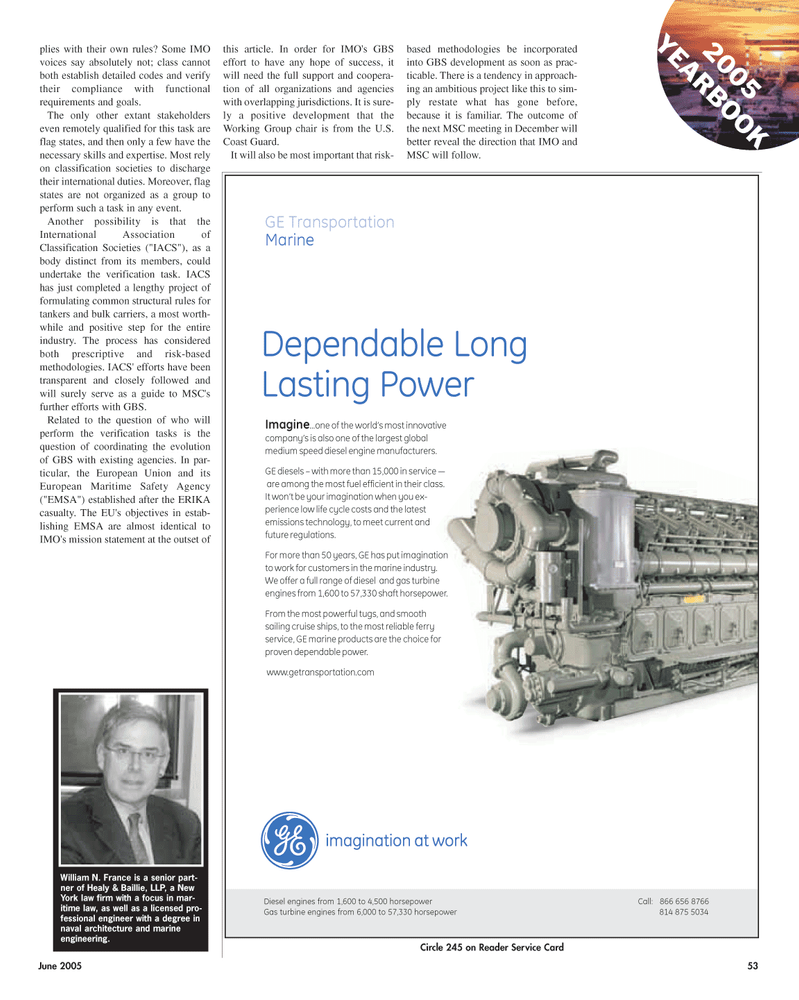
Page 53: of Maritime Reporter Magazine (June 2005)
Annual World Yearbook
Read this page in Pdf, Flash or Html5 edition of June 2005 Maritime Reporter Magazine
June 2005 53 plies with their own rules? Some IMO voices say absolutely not; class cannot both establish detailed codes and verify their compliance with functional requirements and goals.
The only other extant stakeholders even remotely qualified for this task are flag states, and then only a few have the necessary skills and expertise. Most rely on classification societies to discharge their international duties. Moreover, flag states are not organized as a group to perform such a task in any event.
Another possibility is that the
International Association of
Classification Societies ("IACS"), as a body distinct from its members, could undertake the verification task. IACS has just completed a lengthy project of formulating common structural rules for tankers and bulk carriers, a most worth- while and positive step for the entire industry. The process has considered both prescriptive and risk-based methodologies. IACS' efforts have been transparent and closely followed and will surely serve as a guide to MSC's further efforts with GBS.
Related to the question of who will perform the verification tasks is the question of coordinating the evolution of GBS with existing agencies. In par- ticular, the European Union and its
European Maritime Safety Agency ("EMSA") established after the ERIKA casualty. The EU's objectives in estab- lishing EMSA are almost identical to
IMO's mission statement at the outset of this article. In order for IMO's GBS effort to have any hope of success, it will need the full support and coopera- tion of all organizations and agencies with overlapping jurisdictions. It is sure- ly a positive development that the
Working Group chair is from the U.S.
Coast Guard.
It will also be most important that risk- based methodologies be incorporated into GBS development as soon as prac- ticable. There is a tendency in approach- ing an ambitious project like this to sim- ply restate what has gone before, because it is familiar. The outcome of the next MSC meeting in December will better reveal the direction that IMO and
MSC will follow.
Circle 245 on Reader Service Card
Diesel engines from 1,600 to 4,500 horsepower Call: 866 656 8766
Gas turbine engines from 6,000 to 57,330 horsepower 814 875 5034
GE Transportation
Marine
Dependable Long
Lasting Power
Imagine…one of the world’s most innovative company’s is also one of the largest global medium speed diesel engine manufacturers.
GE diesels – with more than 15,000 in service — are among the most fuel efficient in their class.
It won’t be your imagination when you ex- perience low life cycle costs and the latest emissions technology, to meet current and future regulations.
For more than 50 years, GE has put imagination to work for customers in the marine industry.
We offer a full range of diesel and gas turbine engines from 1,600 to 57,330 shaft horsepower.
From the most powerful tugs, and smooth sailing cruise ships, to the most reliable ferry service, GE marine products are the choice for proven dependable power. www.getransportation.com 2005
YEARBOOK
William N. France is a senior part- ner of Healy & Baillie, LLP, a New
York law firm with a focus in mar- itime law, as well as a licensed pro- fessional engineer with a degree in naval architecture and marine engineering.
MR JUNE 2005 #7 (49-56).qxd 6/2/2005 3:07 PM Page 53

 52
52

 54
54
